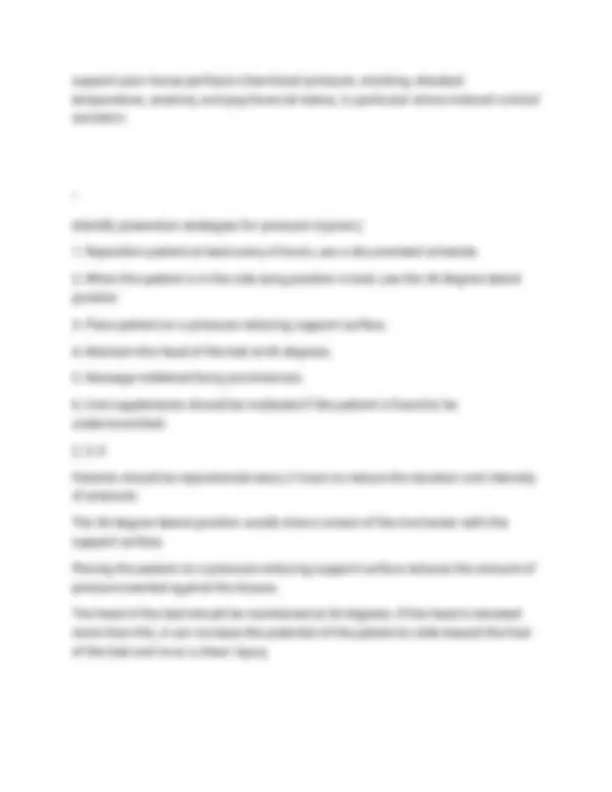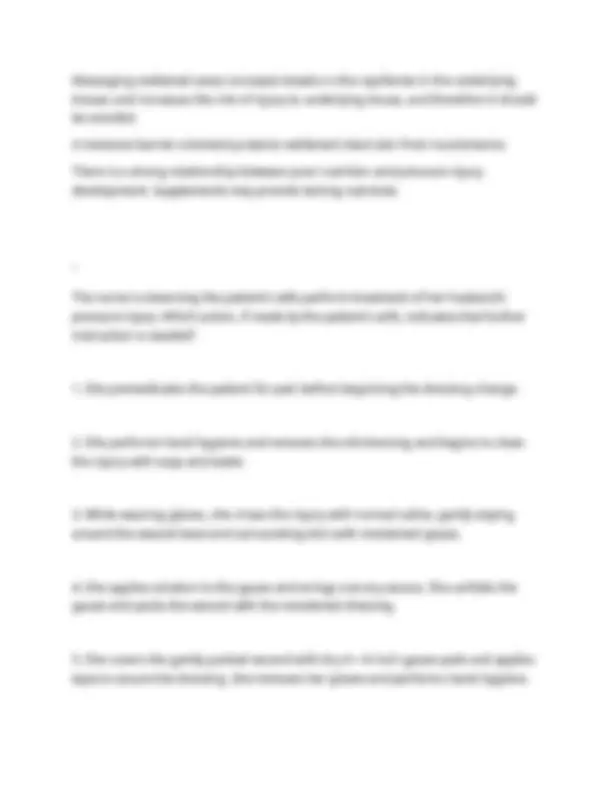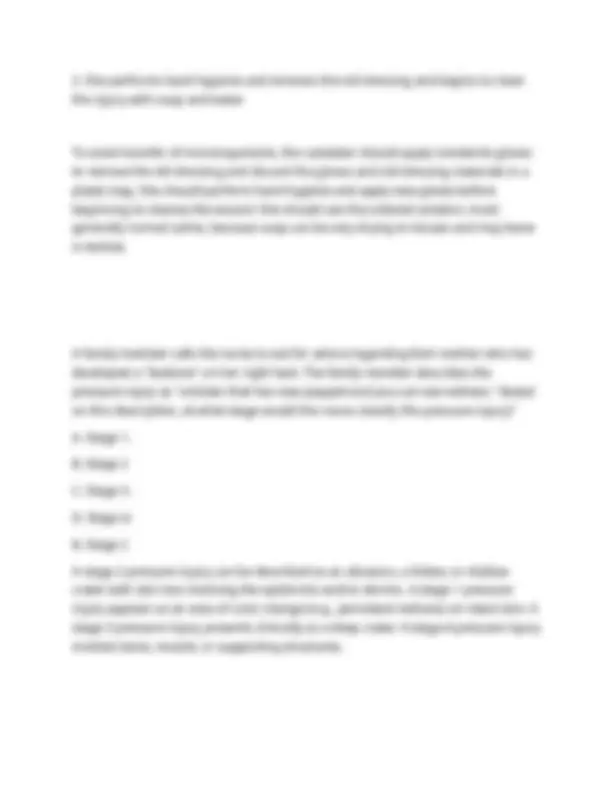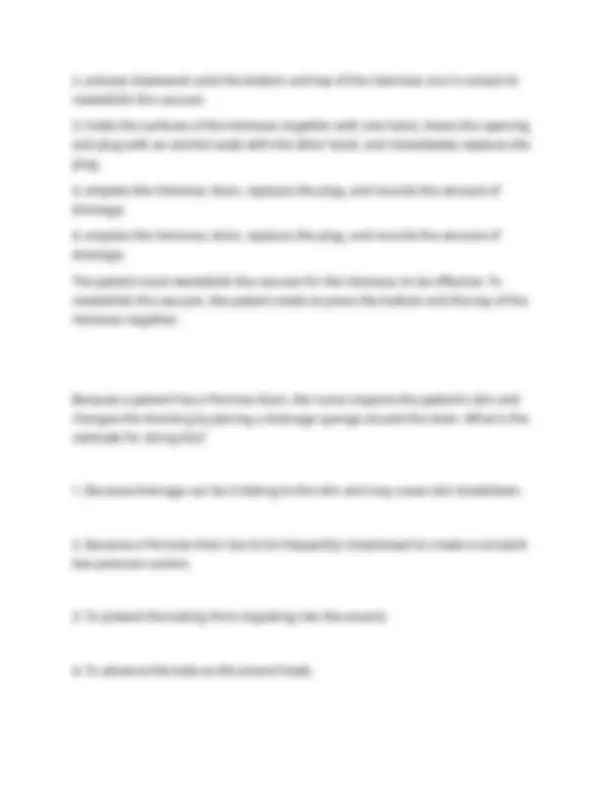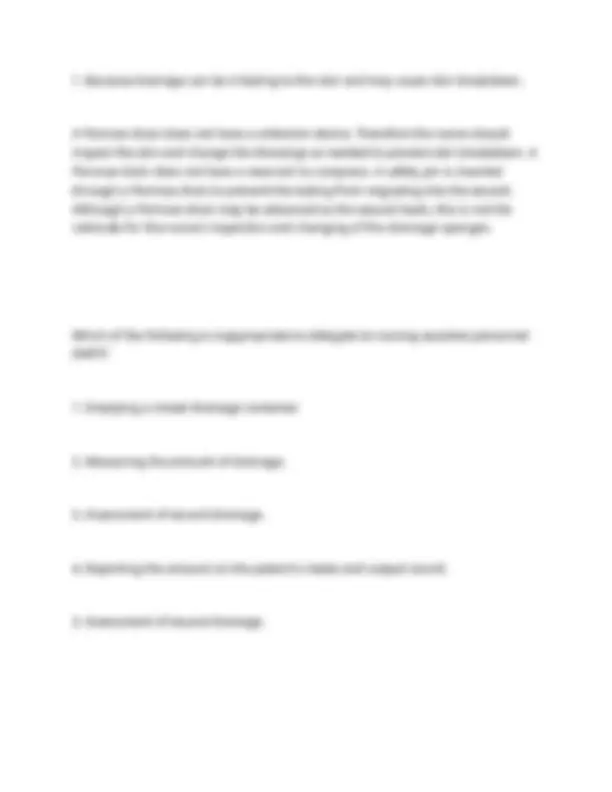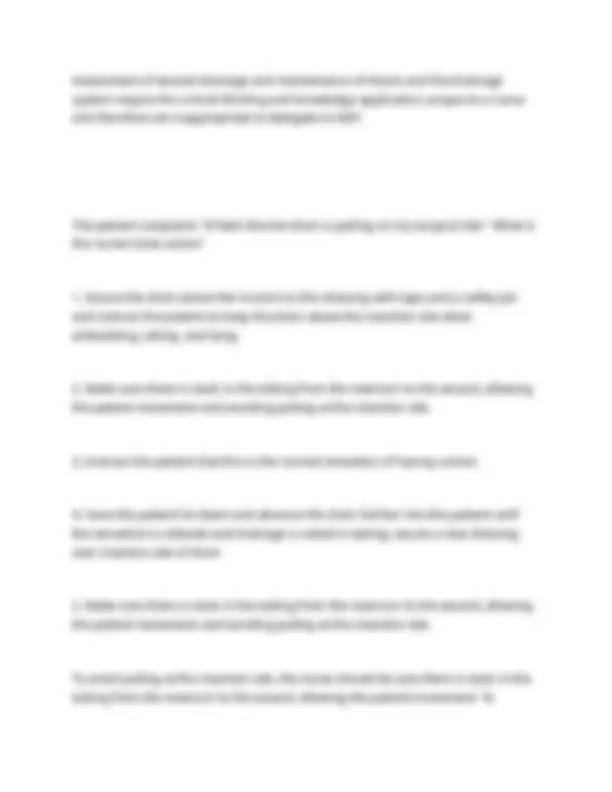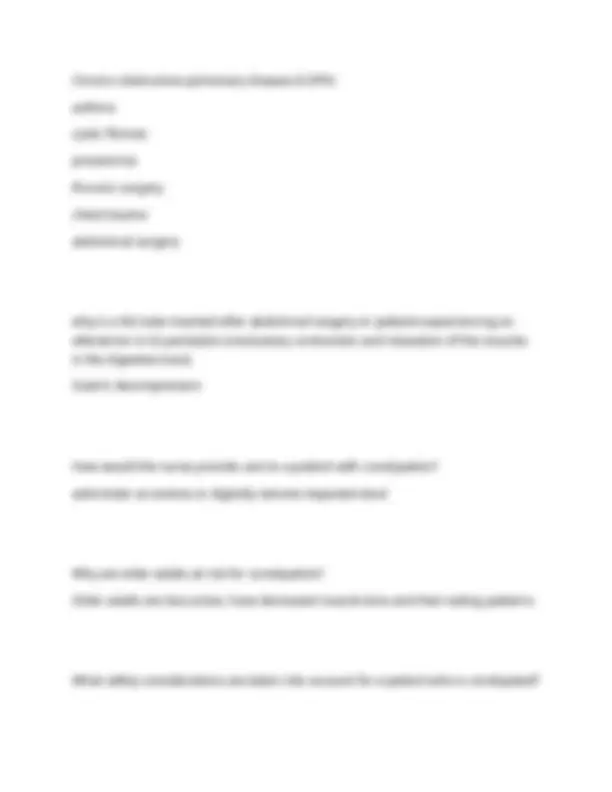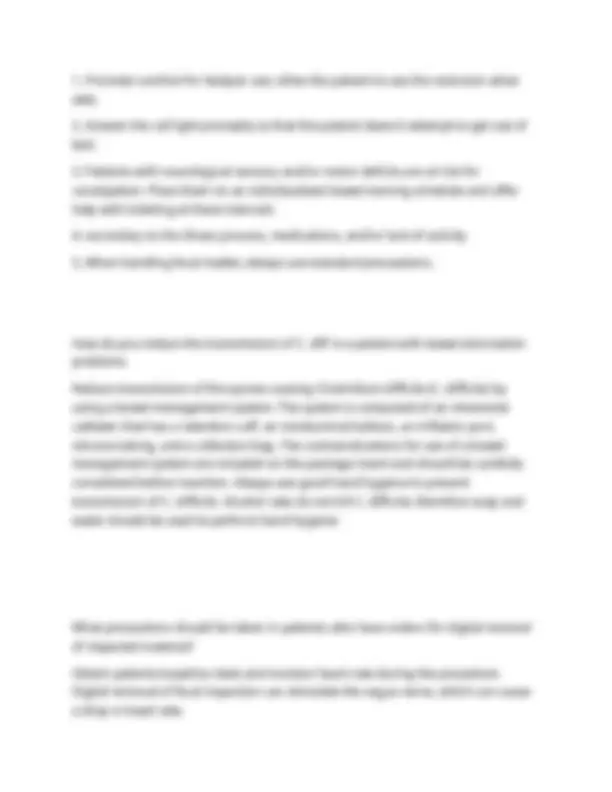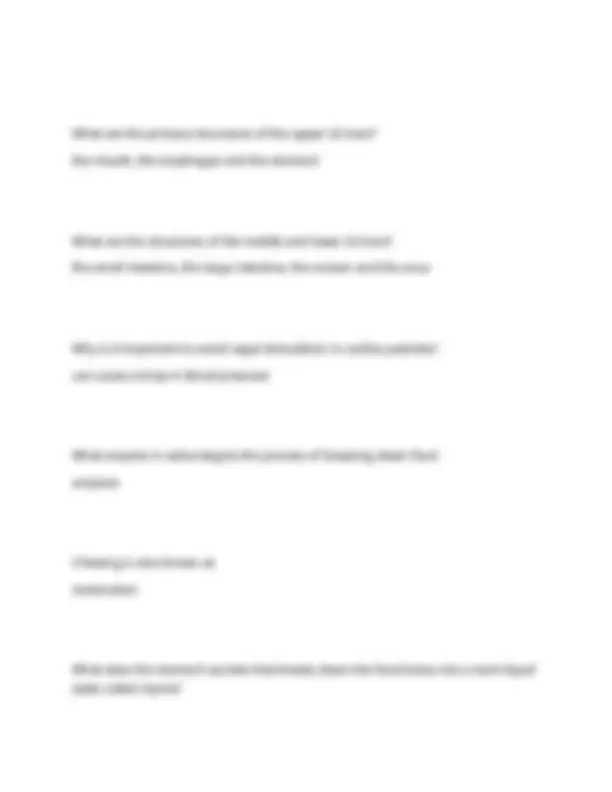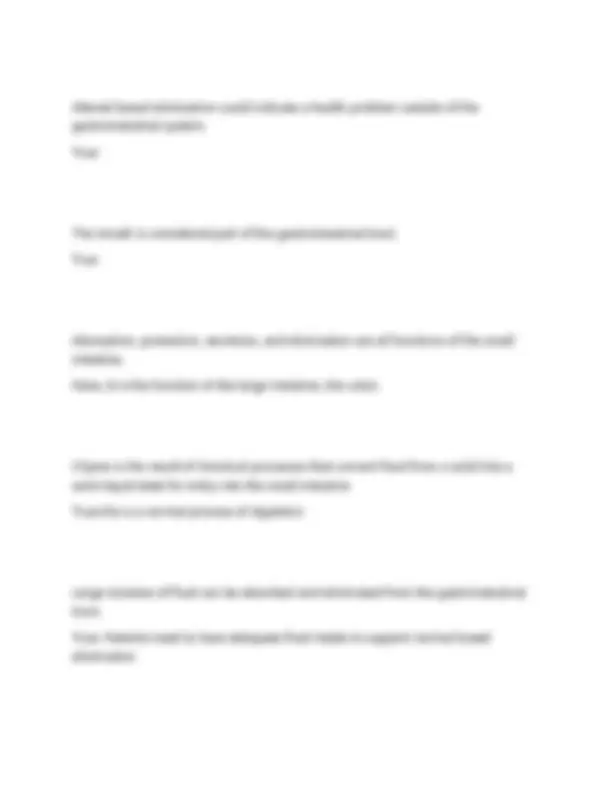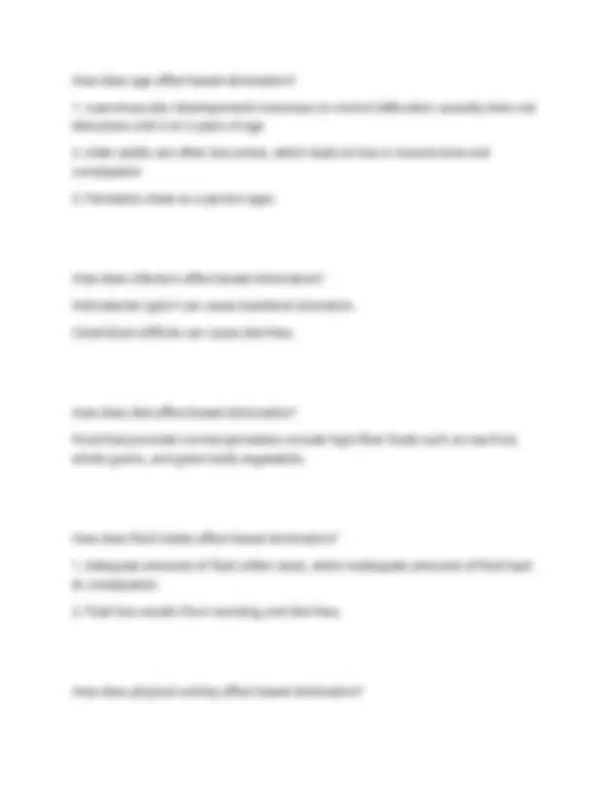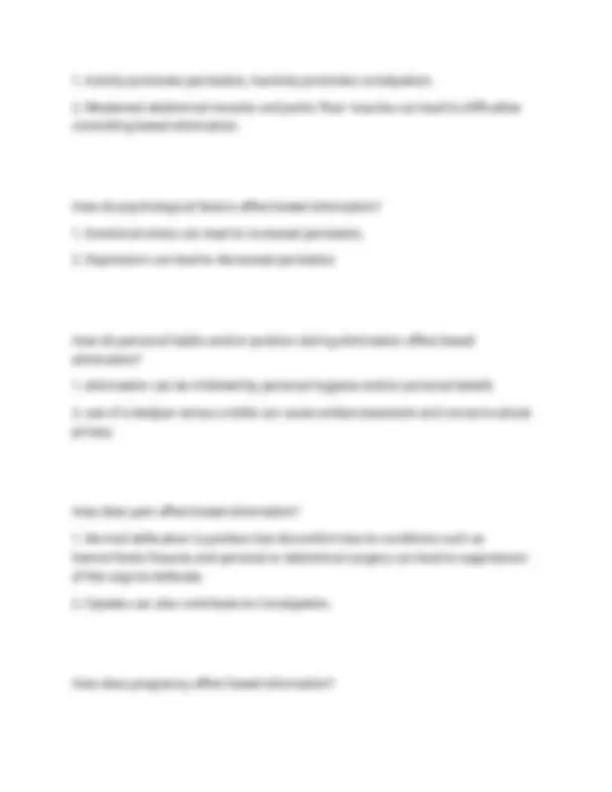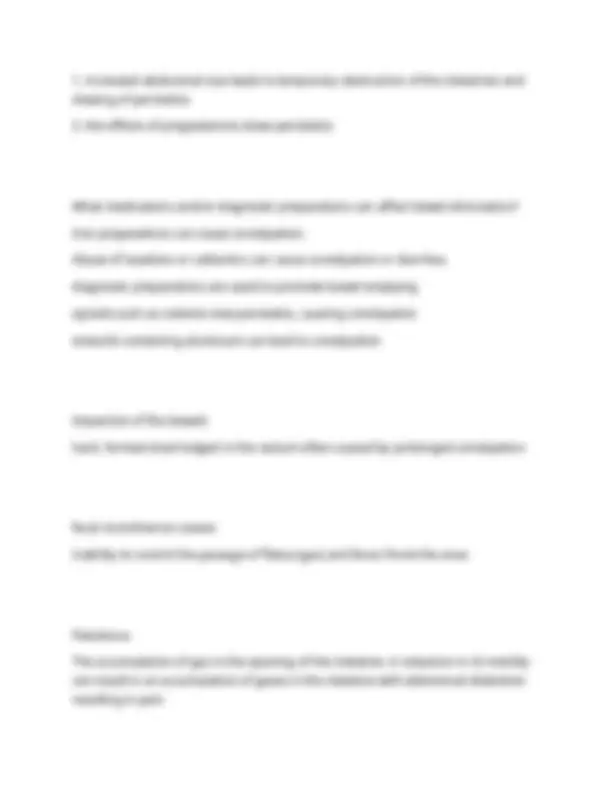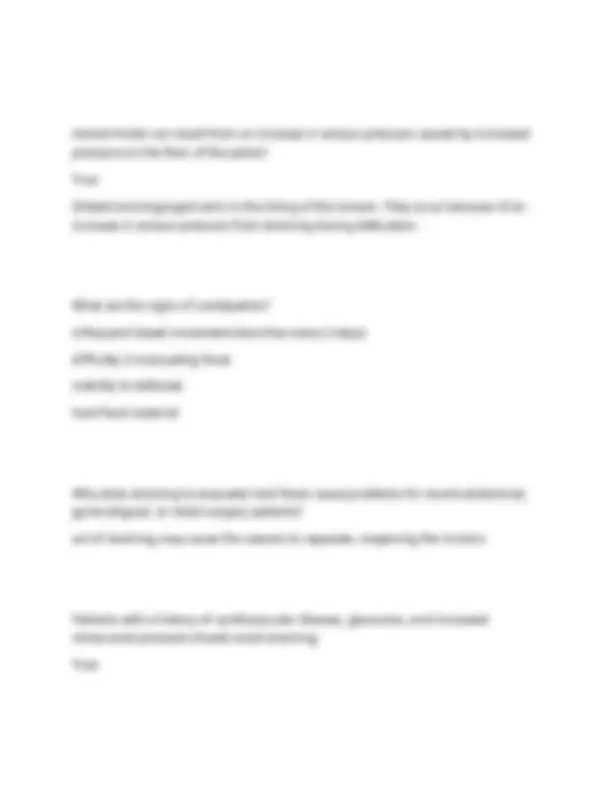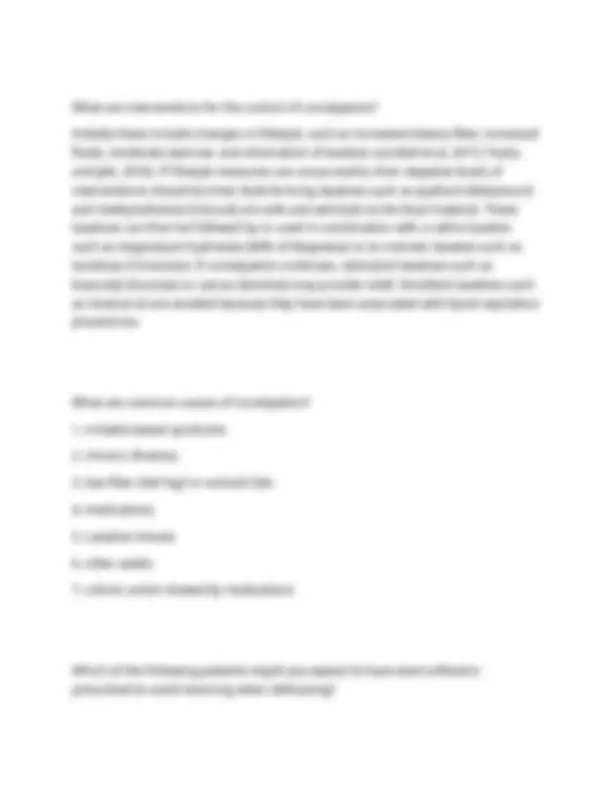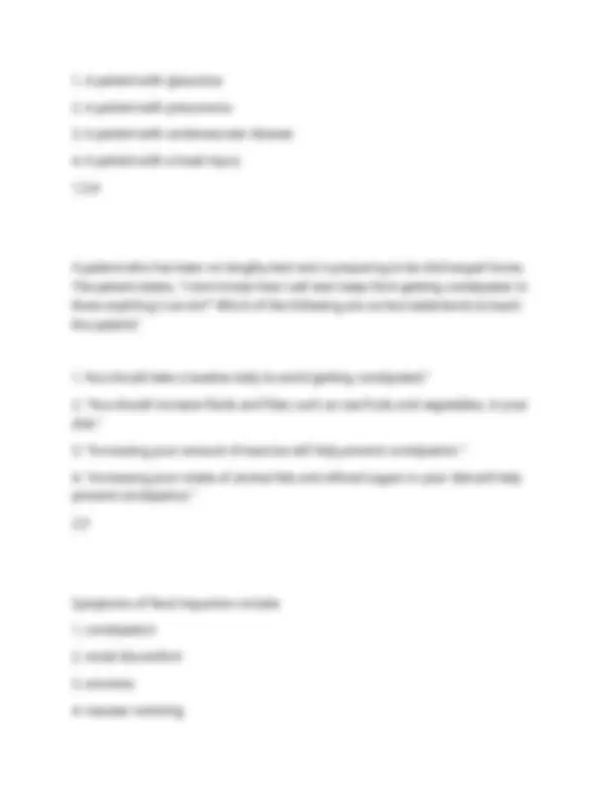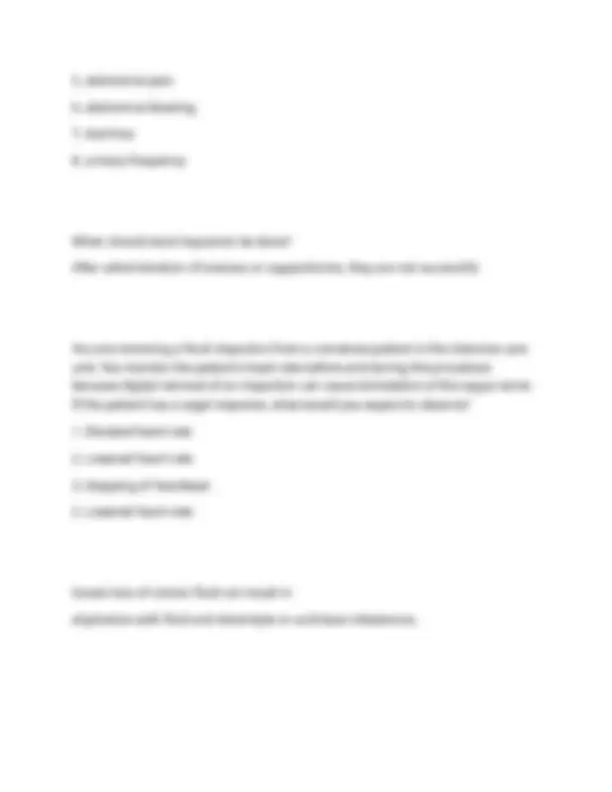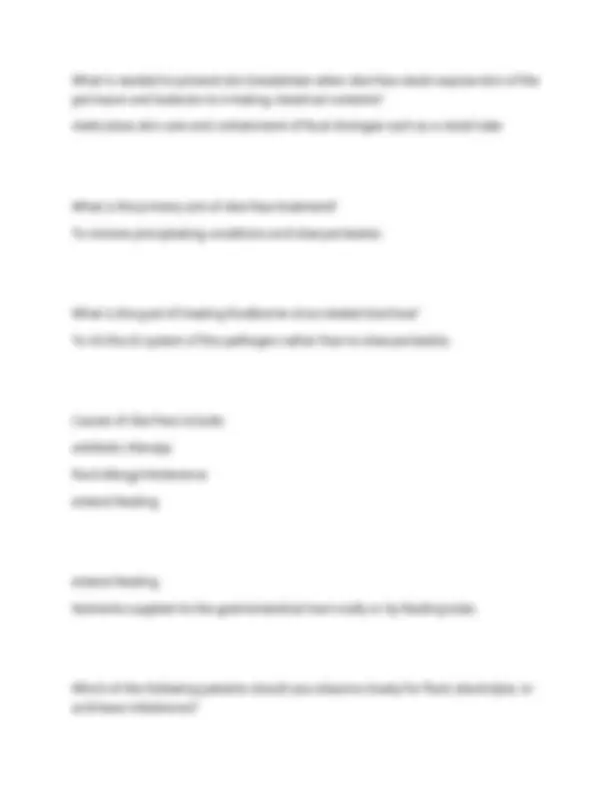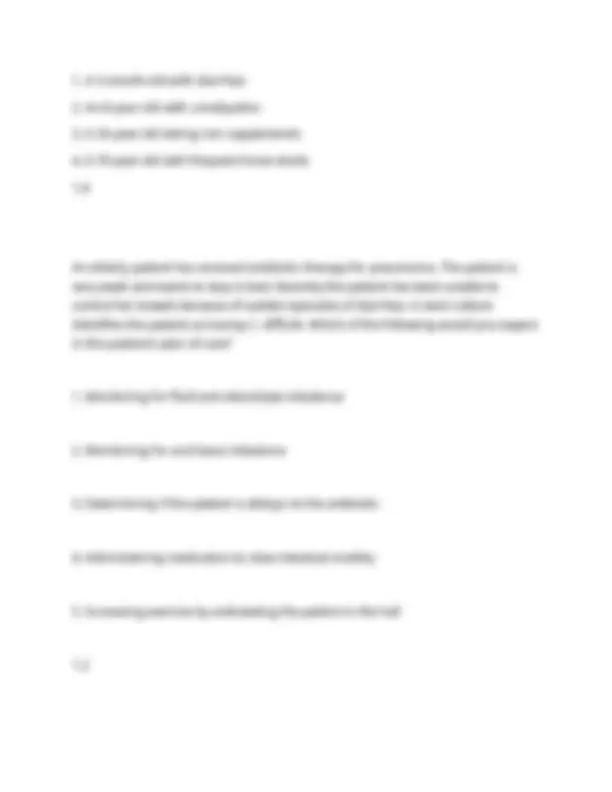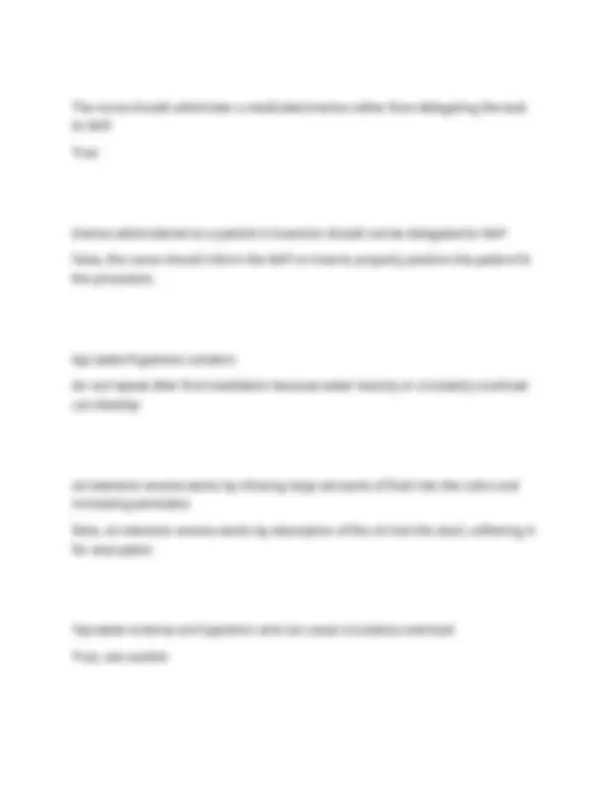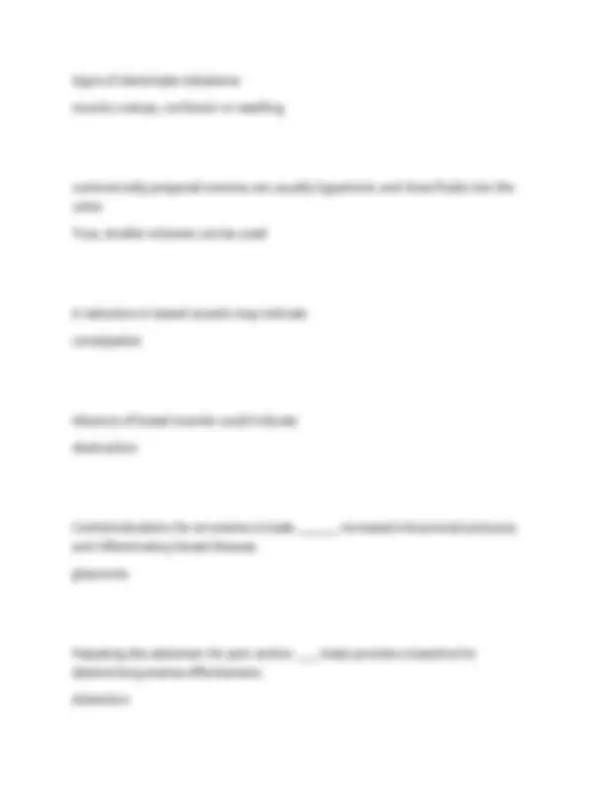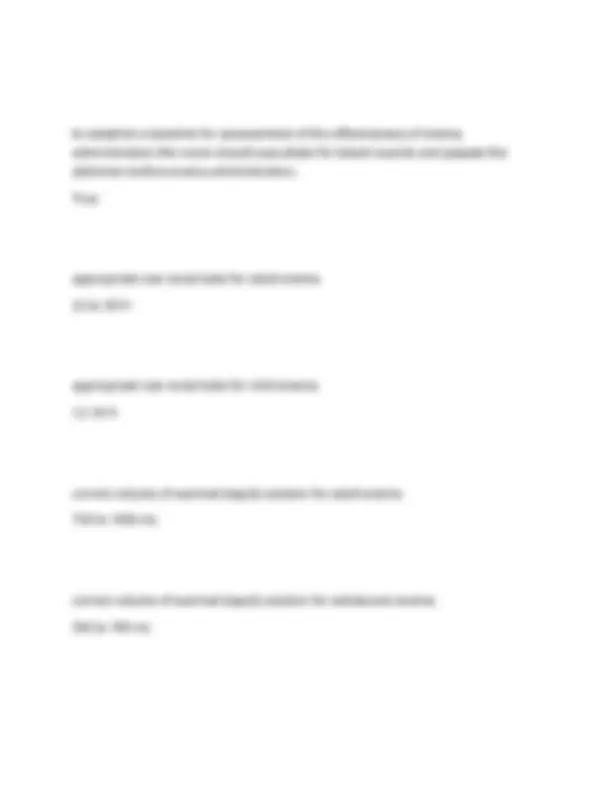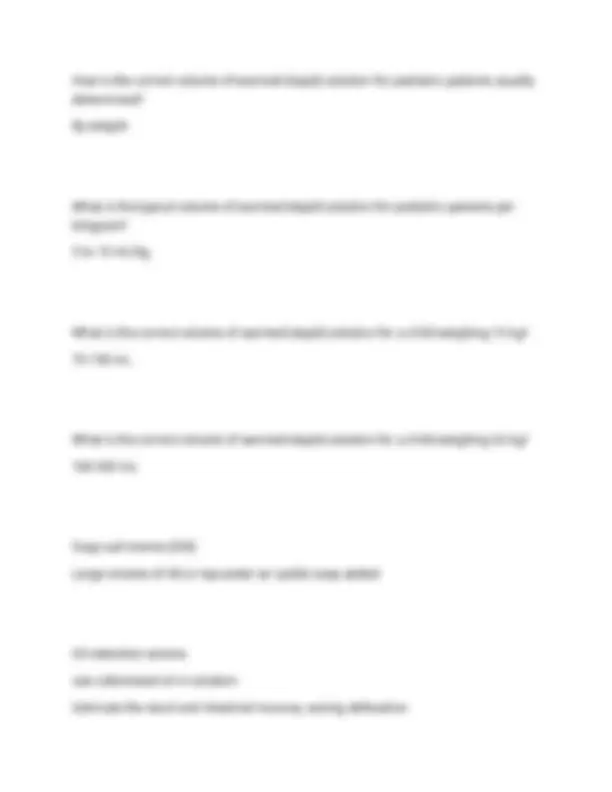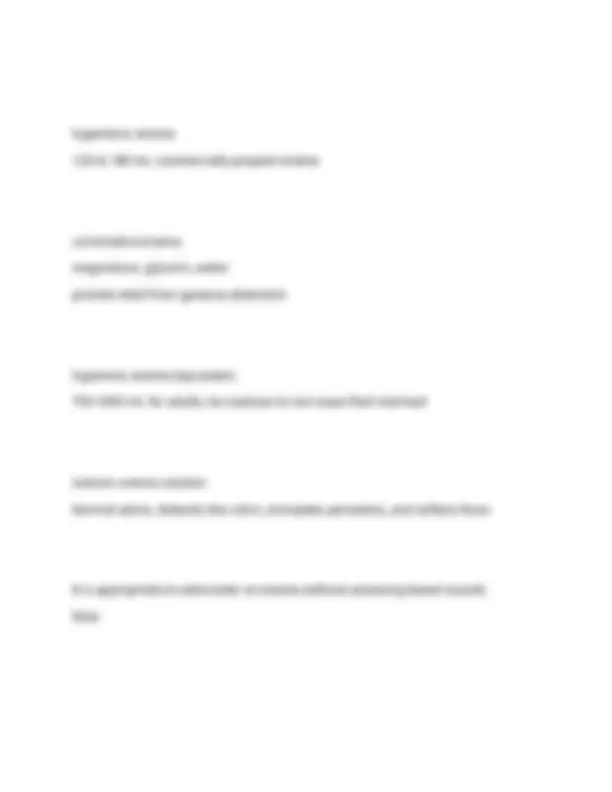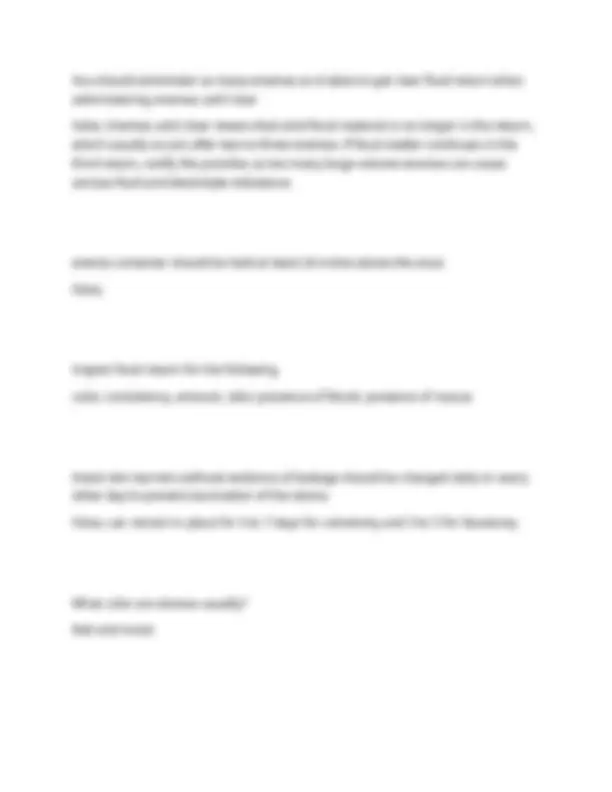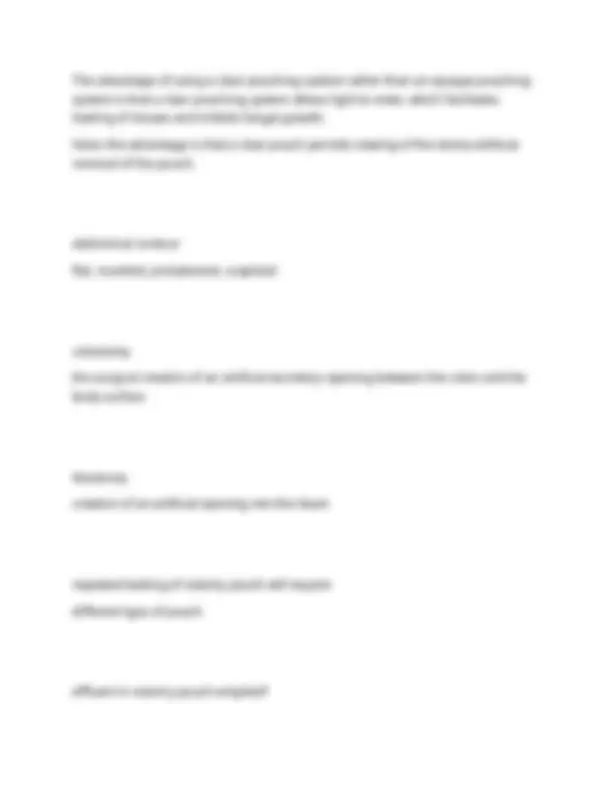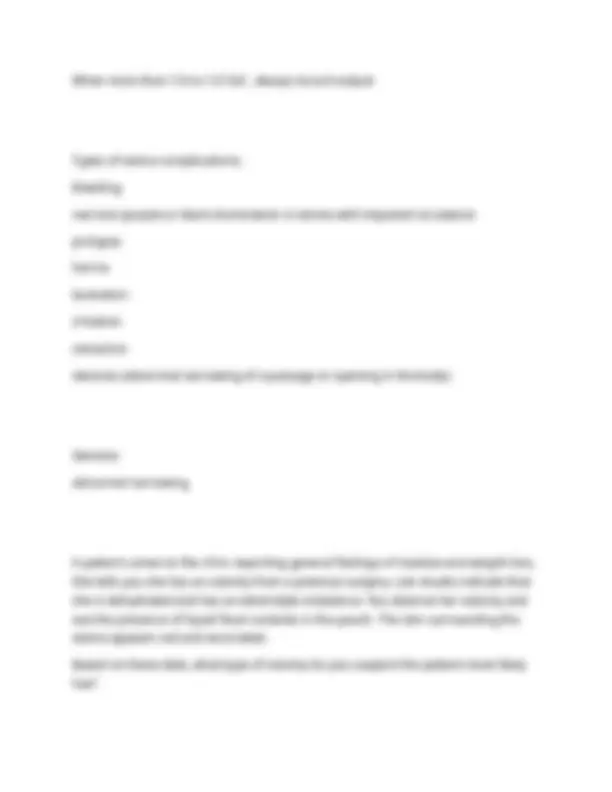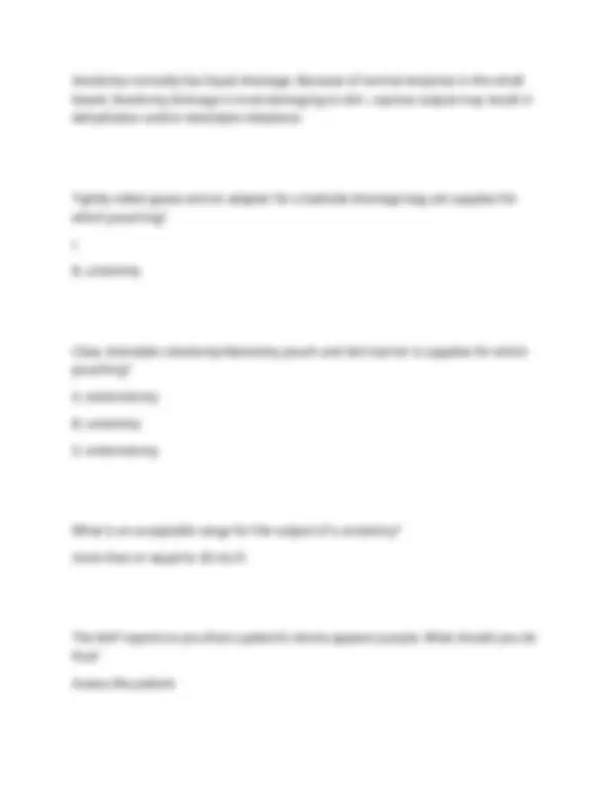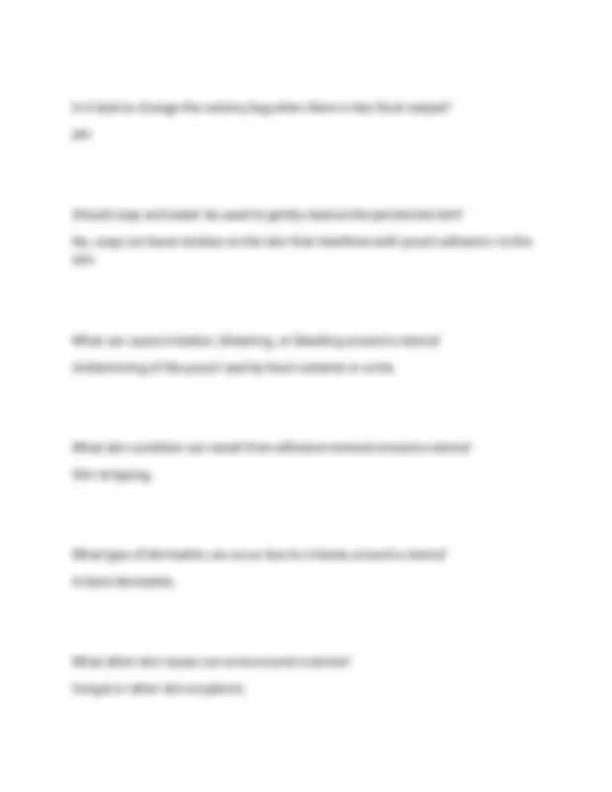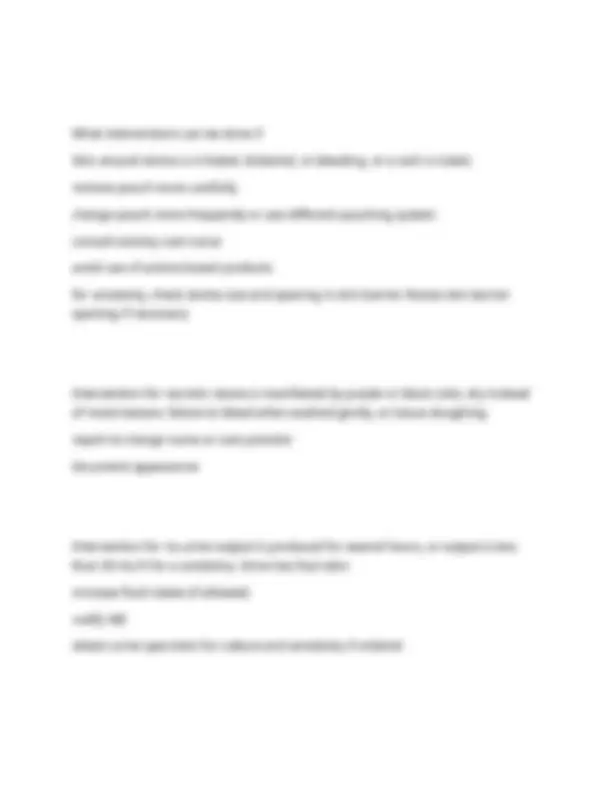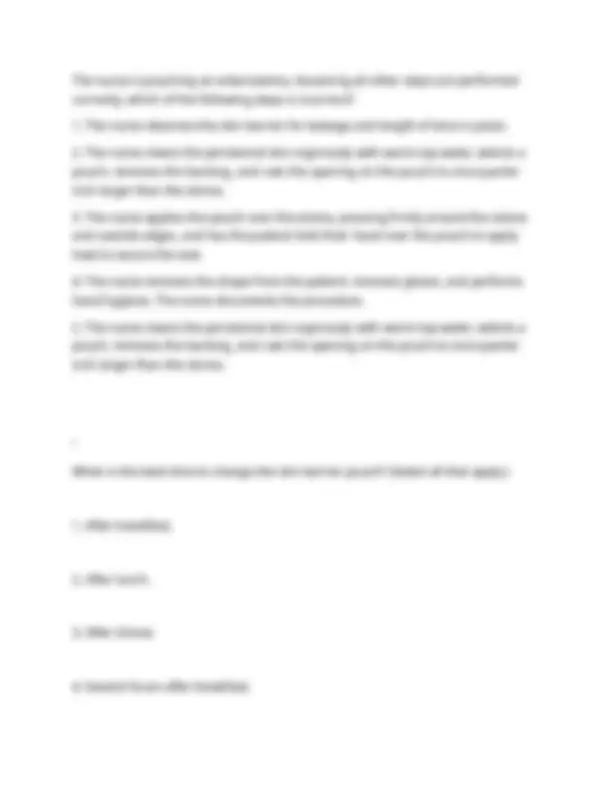Download Pressure Injury Management: Questions and Answers for Nursing Students and more Exams Nursing in PDF only on Docsity!
BSN206 HALLMARK FINAL EXAM ALL
125 QUESTIONS AND CORRECT
ANSWERS GRADED A+
Which of the following are common sites for the development of pressure injuries? (Select all that apply.) Sternum. Heels. Sacrum .Lateral malleoli. (ankle) bones Trochanters (hip region) .Ischial tuberosities. (sit bones) heels, sacrum, trochanters, ischial tuberosities, lateral malleoli
Identify contributing factors to pressure injury formation. (Select all that apply.) Malnutrition. Middle age .Decreased sensory perception/mobility Anemia. Excessive sweating. Ethnic background. *mal nutrition (can impair skin integrity) *decrease sensory perception/mobility (inability to detect or relieve pressure *excessive sweating (moisture can contribute to skin breakdown) *Anemia (can reduce oxygen supply to tissue, affecting skin health) Three pressure-related forces contribute to the development of a pressure injury: intensity of pressure (how much pressure is applied), duration of pressure (how long the pressure is applied), and tissue tolerance (the ability of the tissue to redistribute the weight). Having decreased mobility or decreased ability to perceive the need to shift one's weight or change position places an individual at risk for pressure injury development. Three extrinsic factors, shear, friction, and moisture, make the tissues less tolerant of pressure. Other factors important in pressure injury development include poor nutrition, advanced age, medical conditions that
Massaging reddened areas increases breaks in the capillaries in the underlying tissues and increases the risk of injury to underlying tissue, and therefore it should be avoided. A moisture barrier ointment protects reddened intact skin from incontinence. There is a strong relationship between poor nutrition and pressure injury development. Supplements may provide lacking nutrients “ The nurse is observing the patient's wife perform treatment of her husband's pressure injury. Which action, if made by the patient's wife, indicates that further instruction is needed?
- She premedicates the patient for pain before beginning the dressing change.
- She performs hand hygiene and removes the old dressing and begins to clean the injury with soap and water.
- While wearing gloves, she rinses the injury with normal saline, gently wiping around the wound base and surrounding skin with moistened gauze.
- She applies solution to the gauze and wrings out any excess. She unfolds the gauze and packs the wound with the moistened dressing.
- She covers the gently packed wound with dry 4 × 4–inch gauze pads and applies tape to secure the dressing. She removes her gloves and performs hand hygiene.
- She performs hand hygiene and removes the old dressing and begins to clean the injury with soap and water. To avoid transfer of microorganisms, the caretaker should apply nonsterile gloves to remove the old dressing and discard the gloves and old dressing materials in a plastic bag. She should perform hand hygiene and apply new gloves before beginning to cleanse the wound. She should use the ordered solution, most generally normal saline, because soap can be very drying to tissues and may leave a residue. A family member calls the nurse to ask for advice regarding their mother who has developed a "bedsore" on her right heel. The family member describes the pressure injury as "a blister that has now popped and you can see redness." Based on this description, at what stage would the nurse classify this pressure injury? A. Stage 1. B. Stage 2 C. Stage 3. D. Stage 4. B. Stage 2 A stage 2 pressure injury can be described as an abrasion, a blister, or shallow crater with skin loss involving the epidermis and/or dermis. A stage 1 pressure injury appears as an area of color change (e.g., persistent redness) on intact skin. A stage 3 pressure injury presents clinically as a deep crater. A stage 4 pressure injury involves bone, muscle, or supporting structures.
If drainage suddenly stops, the drainage tubing may have a blockage. Notify the health care provider. The drain reservoir should be emptied every 8 hours or less if the reservoir becomes one-half to two-thirds full. The patient should keep a record of the drain's output in 24 hours to aid in determining whether the amount is decreasing as expected and when the drain may be removed. The reservoir should remain compressed to provide a constant low suction. When should wound drainage be cultured?
- When there is a change in color, amount, or odor of drainage.
- If the patient complains of pain.
- When the drain is removed.
- If the nurse empties the drainage evacuator without applying sterile gloves.
- When there is a change in color, amount, or odor of drainage. Wound drainage should be cultured when infection is suspected, as indicated by the drainage appearing to be purulent, a change in the amount or color of the wound drainage, or a foul odor of the drainage being noted. It is appropriate for the nurse to wear clean gloves to empty the drainage evacuator. “ The nurse is teaching a patient how to empty his Hemovac drain. Which action of the patient indicates that further instruction is needed? The patient:
- opens the plug on the port for emptying the drainage reservoir and drains the contents into the measuring container.
- presses downward until the bottom and top of the Hemovac are in contact to reestablish the vacuum.
- holds the surfaces of the Hemovac together with one hand, cleans the opening and plug with an alcohol swab with the other hand, and immediately replaces the plug.
- empties the Hemovac drain, replaces the plug, and records the amount of drainage.
- empties the Hemovac drain, replaces the plug, and records the amount of drainage. The patient must reestablish the vacuum for the Hemovac to be effective. To reestablish the vacuum, the patient needs to press the bottom and the top of the Hemovac together. Because a patient has a Penrose drain, the nurse inspects the patient's skin and changes the dressing by placing a drainage sponge around the drain. What is the rationale for doing this?
- Because drainage can be irritating to the skin and may cause skin breakdown.
- Because a Penrose drain has to be frequently compressed to create a constant low-pressure suction.
- To prevent the tubing from migrating into the wound.
- To advance the tube as the wound heals.
Assessment of wound drainage and maintenance of drains and the drainage system require the critical thinking and knowledge application unique to a nurse and therefore are inappropriate to delegate to NAP. The patient complains "It feels like the drain is pulling on my surgical site." What is the nurse’s best action?
- Secure the drain above the incision to the dressing with tape and a safety pin and instruct the patient to keep the drain above the insertion site when ambulating, sitting, and lying.
- Make sure there is slack in the tubing from the reservoir to the wound, allowing the patient movement and avoiding pulling at the insertion site.
- Instruct the patient that this is the normal sensation of having a drain.
- Have the patient lie down and advance the drain further into the patient until the sensation is relieved and drainage is noted in tubing; secure a new dressing over insertion site of drain
- Make sure there is slack in the tubing from the reservoir to the wound, allowing the patient movement and avoiding pulling at the insertion site. To avoid pulling at the insertion site, the nurse should be sure there is slack in the tubing from the reservoir to the wound, allowing the patient movement. To
facilitate drainage, the nurse should secure the drain below the incision to the dressing with tape and a safety pin and instruct the patient to keep the drain below the insertion site when ambulating, sitting, and lying. If the patient is complaining of pain, the nurse should further assess the patient to determine if there is undue tension on the drain tubing. The nurse should not advance the tube into the patient because this would introduce microorganisms. “ Positive effects of profusion on skin integrity adequate profusion allows oxygen and nutrients to nourish the skin, promoting a healthy protective skin barrier. Negative effects of profusion on skin integrity Poor or inadequate perfusion decreases the supply of oxygen and nutrients to the skin, causing it to deteriorate, producing a weak barrier. A prolonged decrease in oxygen to the skin produces the following results:
- decrease collagen formation
- reduced production of cells that make collagen (fibroblasts)
- decreased number of white blood cells (leukocytes)
- reduced migration of cells that help the skin regenerate Primary goal of air way management?
Chronic obstructive pulmonary disease (COPD) asthma cystic fibrosis pneumonia thoracic surgery chest trauma abdominal surgery why is a NG tube inserted after abdominal surgery or patients experiencing an alteratrion in GI peristalsis (involuntary contraction and relaxation of the muscles in the digestive tract) Gastric decompression How would the nurse provide care to a patient with constipation? administer an enema or digitally remove impacted stool Why are older adults at risk for constipation? Older adults are less active, have decreased muscle tone and their eating patterns What safety considerations are taken into account for a patient who is constipated?
- Promote comfort for bedpan use; allow the patient to use the restroom when able.
- Answer the call light promptly so that the patient doesn't attempt to get out of bed.
- Patients with neurological sensory and/or motor deficits are at risk for constipation. Place them on an individualized bowel training schedule and offer help with toileting at these intervals
- secondary to the illness process, medications, and/or lack of activity
- When handling fecal matter, always use standard precautions. How do you reduce the transmission of C. diff in a patient with bowel elimination problems Reduce transmission of the spores causing Clostridium difficile (C. difficile) by using a bowel management system. The system is composed of an intrarectal catheter that has a retention cuff, an intraluminal balloon, an inflation port, silicone tubing, and a collection bag. The contraindications for use of a bowel management system are included on the package insert and should be carefully considered before insertion. Always use good hand hygiene to prevent transmission of C. difficile. Alcohol rubs do not kill C. difficile; therefore soap and water should be used to perform hand hygiene What precautions should be taken in patients who have orders for digital removal of impacted material? Obtain patients baseline vitals and monitor heart rate during the procedure. Digital removal of fecal impaction can stimulate the vagus nerve, which can cause a drop in heart rate.
hydrochloric acid, pepsin, intrinsic factor, and mucus What is the small intestine composed of?
- Duodenum
- Jejunum
- Ileum What breaks down chyme in the small intestines? enzymes produced by the pancreas and the gallbladder which aide in the breakdown of fats, protein and carbohydrates What are absorbed by the ileum after peristalsis of chyme through the small intestine? vitamins, iron and bile salts where does the remaining chyme enter the large intestine (colon)? through the ileocecal valve at the cecum After the chyme enters the colon through the cecum where does it go?
- ascending colon (right side, moves up)
- transverse colon (across )
- Descending colon (left side, moves down)
- rectum What are the four primary functions of the colon?
- Absorption of sodium, water and chloride
- Protection- of sensitive tissue lining of colon through the release of mucus
- Secretion- bicarbonate for cloride and the release of potassium
- Elimination- waste products and gas (flatus) Where is fecal matter stored before elimination? sigmoid section of the colon What is absorbed in the GI tract from foods and the fluids/secretions from organs, such as the pancreas and gallbladder? large amounts of fluids The upper gastrointestinal system includes the small intestine and the transverse colon. False
How does age affect bowel elimination?
- nueromuscular developement necessary to control defecation ususally does not take place until 2 to 3 years of age
- older adults are often less active, which leads to loss in muscle tone and constipation
- Peristalsis slows as a person ages How does infection affect bowel elimination? Helicobacter pylori can cause duodenal ulceration. Clostridium difficile can cause diarrhea. How does diet affect bowel elimination? Food that promote normal peristalsis include high-fiber foods such as raw fruit, whole grains, and green leafy vegetables. How does fluid intake affect bowel elimination?
- Adequate amounts of fluid soften stool, while inadequate amounts of fluid lead to constipation.
- Fluid loss results from vomiting and diarrhea. How does physical activity affect bowel elimination?
- Activity promotes peristalsis; inactivity promotes constipation.
- Weakened abdominal muscles and pelvic floor muscles can lead to difficulties controlling bowel elimination. How do psychological factors affect bowel elimination?
- Emotional stress can lead to increased peristalsis.
- Depression can lead to decreased peristalsis How do personal habits and/or position during elimination affect bowel elimination?
- elimination can be inhibited by personal hygiene and/or personal beliefs
- use of a bedpan versus a toilet can cause embarrassement and concerns about privacy How does pain affect bowel elimination?
- Normal defecation is painless but discomfort due to conditions such as hemorrhoids fissures and perianal or abdominal surgery can lead to suppression of the urge to defecate.
- Opiates can also contribute to Constipation. How does pregnancy affect bowel elimination?

